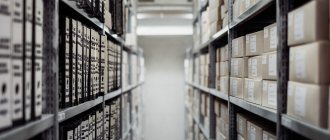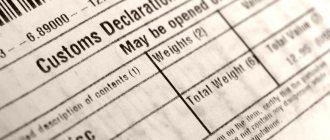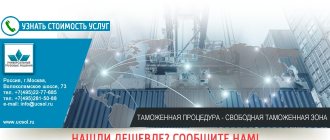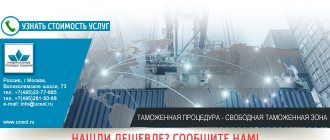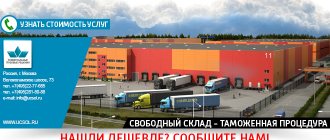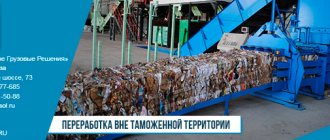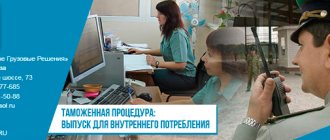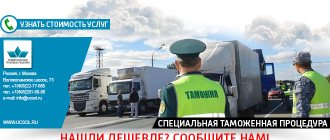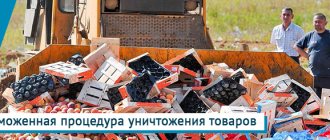HomeCustoms clearancecustoms control
Customs control (CC) is one of the main functions of customs authorities. It is associated with the prevention and suppression of violations of international, union and national legislation in the field of customs regulation. The executive authorities entrusted with the functions of customs control are the structural divisions of the Federal Customs Service of the Russian Federation: customs posts, customs houses, regional customs departments, departments of the Central Office of the Federal Customs Service of the Russian Federation (more details).
| Levels of customs authorities by competence in the field of customs control of goods | |
| Tactical | Grassroots level. Control at this level is carried out by customs posts and customs offices. They define areas of risk that are specific to short-term situations, specific individuals and specific cargo. |
| Operational | Average level. Control at this level is carried out by regional customs departments (RTU) of the Federal Customs Service of the Russian Federation. They determine local areas of risk in relation to individuals, goods or customs authorities, and distribute the competencies of subordinate units at the lower level. |
| Strategic | Highest level. Customs control is managed by the Federal Customs Service of the Russian Federation. Here, risk areas with the highest probability of potential violation of customs legislation and the greatest amount of damage in the event of risks are determined. Analysis of such risks allows us to further develop and implement measures to prevent violations of the law and minimize their consequences. |
The divisions of the Federal Customs Service of the Russian Federation have been assigned customs control goals.
General overview
It is worth saying right away that compensation for all financial costs incurred, even if the scheme in question is used, is possible only if the contract initially includes the obligation of the other party to compensate for losses incurred. The service exercising border control, in accordance with the provisions of Art. 238 of the Customs Code of the EAEU, has the right to reimburse the importer only the amount of value added tax and payments at current tariff rates. In this case, the basic fee, paid directly for the fact of filing the declaration, as well as transport and logistics costs, can be received from the sender - if the contract provides for the option of filing a corresponding claim.
Specialists of SEA BANK are ready to offer favorable terms for corporate services, cash settlement services (cash settlement services), and also provide a bank guarantee.
Legal status of a customs representative: requirements and legal status of a broker
On the cooperation side, it is impossible to name any disadvantages for the client, with the exception of the need to pay according to the contract. However, this rule is only possible if you cooperate with a conscientious and responsible specialist. In practice, fraud does not occur in this industry, since in order to provide services, clients will have to confirm their status, which is assigned only if certain points are met, which can be considered disadvantages of the profession:
- mandatory licensing and inclusion in a unified Register;
- submitting reports to the department at least every 6 months;
- payment of 500 thousand Euros for conducting brokerage activities without restrictions;
- bearing responsibility for the cargo and its safety to customs and the customer;
- payment of all fees on behalf of the principal and representation of his interests.
If a legal entity operates in regular violation of the terms of the contract, laws and other regulations, then it is excluded from the Register. It is precisely such strict measures and the definition of functions about who can be a customs representative that make it possible to improve the quality of services provided to customers, as well as monitor the legality of all manipulations.
In fact, starting from 2021, all processes in foreign economic activity are undergoing changes that have arisen due to devaluation, the imposition of sanctions, and the integration of an import substitution program. At the same time, representation has become less in demand due to the introduction of electronic services with tips for users. Thus, the market is developing according to the dumping principle, that is, the one who offers help cheaper will be more in demand. European experience shows that today the work of a professional costs no more than 30 Euros. Critical undervaluation of prices in a real situation forces us to find regular customers for interaction and enter into long-term contracts with them.
In what situations is it used?
- Dispatch of products in a batch of which a manufacturing defect was detected, or non-compliance with the conditions or technical characteristics specified in the contract.
- Conducting transactions with the participation of a third party, in which a company from the Russian Federation acts as an intermediary between a seller and a buyer from other countries.
The popularity of the re-export scheme in the Customs Union is determined by compliance with the legitimate interests of all participants in foreign trade activities.
Technical means of customs control
To increase efficiency, reduce time and labor costs when carrying out customs control, technical means of customs control (TCC) can be used: instruments, instruments, devices. The procedure for their use is regulated by law. Most often, special mirrors, videoscopes, probes and X-ray units are used. The variety of TSTK is very large, this is due to the sophistication of smugglers trying to smuggle cargo secretly. Technology is constantly being improved, new means and new ways of detecting contraband are appearing. But, as before, an ordinary tape measure and scales are actively used. Complex devices allow you to quickly determine the composition of the material from which jewelry is made.
How the procedure is regulated
One of the forms of regulation is currency control - a set of measures, the adoption of which makes it possible to monitor transactions using foreign funds, including in order to satisfy and protect national interests.
Strict regulation and the obligation to accurately execute all related operations necessitate the need to obtain professional support, which the clients of MARINE BANK can always count on. Specialists will provide up-to-date information, help you comply with existing restrictions, and teach you how to manage payment transactions with a minimum of associated costs.
Regulation of re-export under the Customs Code also determines the significance of the substantive component of agreements and contracts concluded between parties involved in foreign trade activities. It is better to seek legal advice in advance - this will minimize the likelihood of circumstances in which the interests of the business will not be protected from a legal point of view. Detailed elaboration of documents regulating relations between counterparties is one of the priorities of work in any direction and segment of international trade.
Mode restrictions
When planning to turn to the scheme under consideration, it is important to take into account that not all goods are placed under the customs re-export procedure. Exceptions include:
- Products located in the Russian Federation for more than 12 months.
- Consignments that are not properly documented in terms of documentation.
- Products that have been repaired or have been in use.
- Objects that cannot be identified by the FCS.
It is worth noting that these requirements can be considered quite flexible for importers. In most cases, the need for a return is determined in the early stages, almost during the process of acceptance and posting, so that the likelihood of the above situations occurring is minimized.
Conditions for placing goods for re-export
The regulation, defined by the regulations, prescribes mandatory compliance with the following standards:
- Products submitted for application of the regime must be qualified as having foreign origin.
- The entity responsible for the import is required to present a permit that officially gives the right to carry out the procedure in relation to a specific group of products.
- Submission of a request for the provision of contract data by border services responsible for the control of re-export operations - this condition helps to eliminate the possibility of transporting prohibited goods. The owner will be required to provide contracts for both incoming and outgoing cargo transportation.
- The declarant must assume all obligations regarding re-export by providing an appropriate receipt drawn up with the assistance of an official customs representative, as well as a letter of guarantee containing information about the accompanying circumstances of storage and movement of the products.
In addition, by signing an agreement for the temporary storage of part of the goods on the territory owned by the controlling agency, the importer must also confirm payment of all fees required by law.
Sign up for the salary project service at SEA BANK to conveniently and quickly deposit your wages. This is beneficial for enterprises and organizations of any size, regardless of the number of staff.
Customs control zone
The customs control zone (CZZ) is a separated, fenced from other space, protected area where customs control activities are carried out. On the territory of the ZTC there are areas for open-air cargo storage, truck parking, warehouses, administrative buildings, and a customs building. Access for citizens and transport is provided only through organized checkpoints. TC zones are either permanent (PZTK) or temporary (VZTK). PZTK are available at major airports, border checkpoints (road and railway), in warehouses (customs and temporary storage warehouses), and free economic zones. PZTK are established to control the import and export of seasonal goods, as well as dangerous or large goods (transportation to the PZTK is problematic/impossible).
In the ZTC, inspectors can stop transport, inspect cargo, and perform other actions. Outside the ZTC, inspectors are also authorized to stop vehicles, but accompanied by traffic police officers.
How is the customs procedure for re-export completed under the EAEU Customs Code?
The possibility of applying a re-export procedure determines that the entity acting as the initiator must first of all explain to representatives of the authorities the reasons for such a decision, as well as prepare the accompanying package of documentation. If these two conditions are met, customs conducts a general inspection of the commercial product, making sure that it has not been exploited in any way while in the possession of the applicant.
In addition to the declaration of the standard form EC 31, the kit also includes:
- Acts confirming the validity of returning the goods.
- Agreement with the supplier.
- Shipping documents.
- Permission to export the product (if necessary).
Potential reasons include not only qualitative discrepancies - similar factors may include the impossibility of fulfilling financial obligations, lack of commercial documentation, etc. One way or another, the decision to reimburse duties and VAT on re-exports is made by customs only after receiving a declaration and written explanation.
Returning to the issue of the supply of low-quality goods, it is also worth mentioning that such a conclusion can be based both on the agreements enshrined in the content of the contract and on legislative norms. To avoid legal disputes, it is recommended to prescribe an algorithm for confirming non-compliance.
Drawing up an act of form TORG-3 in the situation under consideration is not necessary. Practice shows that a detailed description of the problem, as well as photographs indicating the presence of a defect, will be sufficient. If we are talking about complex products, the specifics of which make it difficult to visually record deviations from the norm, the importer will need expert assistance. To obtain an expert opinion, it is enough to contact the Chamber of Commerce and Industry, or to laboratories that have the appropriate accreditation.
Review of the application by the regulatory agency allows us to move on to the stage of inspection of the goods, which makes it possible to ensure that it has not been subjected to exploitation and corresponds to the nomenclature names specified in the documents. This rule is relevant for all types of supplies, be it re-export of cars, household appliances or winter clothing. The procedure itself is carried out at the Federal Customs Service warehouse used for temporary storage.
The final stage of registration is the provision of a free-form letter of guarantee confirming the intention to export the products within a specified period of time.
Sign up for the merchant acquiring service at SEA BANK and accept payments for goods and services using any bank cards, regardless of currency!
Customs control system
The organization of customs control in the Russian Federation is based not only on the customs legislation of the EAEU and national legislation, but also on international treaties that our country has ratified.
The Kyoto Convention on the Simplification and Harmonization of Customs Procedures proclaims the principle of openness of world trade and calls on the countries of the world to create conditions under which foreign trade turnover and legal trade would be accelerated. Customs authorities around the world must ensure the development of international trade without compromising the effectiveness of customs control. The principles proclaimed by the Kyoto Convention became fundamental for the World Customs Organization (WCO), of which the Russian Federation is a member.
It is possible to achieve acceleration of processes in foreign trade turnover through the widespread introduction of automation processes in the procedure for registering goods, the introduction of electronic document flow between participants in foreign trade activities, and also by simplifying the control of goods. International experience of customs organizations suggests that it is quite possible to abandon total control of all flows of goods and replace it with selective control. The customs administrations of European countries reached the point that only 10-15% of the total trade flow was inspected.
In Russia, selective control of goods is also used. That is, not all consignments are inspected (and even this is impossible), but only a part of them. Which product batch will be subject to control measures is determined by the Risk Management System (RMS). Thanks to the algorithms introduced into the system, Russian customs authorities managed to reduce the time required to complete customs procedures and reduce queues at checkpoints.
The RMS operation algorithm is as follows: the system assigns a so-called risk profile to each product batch. The choice of one or another form of customs control depends on the risk profile. In relation to one part of the consignments, such customs control measures as document verification and customs inspection are applied, and in relation to the other part of the consignments, customs inspection measures are applied. And even if the goods have been successfully released by customs under the declared customs procedure, the RMS system can assign measures for customs inspection of premises and territories where customs cleared goods will be placed, and can assign a measure of customs inspection (desk or on-site).
When forming risk profiles, the RMS system analyzes many parameters. They can be divided into external and internal.
Internal includes information recorded in customs databases (world average prices for different groups of goods, average contract amounts for certain goods, declaration databases, information catalogs issued by customs and non-customs authorities, customs statistics and other sources of information). External sources include information received by customs authorities from databases of other executive authorities (from the Federal Tax Service of the Russian Federation, the Ministry of Industry and Trade, Rosalkogolregulirovanie, Rosselkhoznadzor). For this purpose, the capabilities of the SMEV system are actively used. External sources also include information received by Russian customs authorities from customs authorities of other states through international cooperation channels.
The exact number of parameters influencing the formation of risk profiles is not known. According to some information, the RMS system operates about one and a half thousand different parameters when determining the risk profile of a particular product batch, and this number is constantly increasing. What these parameters are is also not known. Based on experience, it can be assumed that the risk profile is influenced by the following parameters.
- Country (region) of origin of the product. Most often, consignments of goods arriving from countries for which goods from which Russia applies so-called counter-sanctions (Ukraine, the USA, EU countries) are subject to inspection. Also, a high risk profile is assigned to goods consignments arriving in our country from regions where there is war or regions with a high level of drug crime.
- Commodity code of goods according to the Commodity Nomenclature of Foreign Economic Activity. Most goods are freely imported and exported from the country, but there are a number of goods for export or import of which you will need to present a license, certificate, declaration, or permit at customs. Some unscrupulous participants in foreign trade activities, in violation of customs legislation, assign a different commodity code to the declared goods. A similar method is used by foreign trade participants to avoid paying duties. The RMS system has information about groups of goods that are most often subject to incorrect declaration. Russian customs authorities often use contacts with colleagues from other countries. If discrepancies are detected between the volumes of exports and imports of certain goods, they also fall into the risk group.
- Foreign trade participant, declarant. The RMS system considers all declarants as bona fide participants in foreign economic activity. However, once a declarant makes a mistake (intentionally or unintentionally), which led to the initiation of an administrative case (without deprivation of a license), all subsequent foreign trade operations of this foreign trade participant will be considered by the RMS system as high-risk. Participants in foreign trade activities with the status of an authorized economic operator, bona fide customs representatives, owners of temporary storage warehouses, customs warehouses, and duty-free shops have the lowest risk profile.
- Number of goods. There is a group of so-called cover goods that serve as a cover for the import of risk goods into the country. Suspicion is raised by large quantities of potato starch, products used to feed animals, timber and other categories of goods, which may be a cover for the import of high-risk goods, or even those prohibited for import or export, smuggling.
- Goods imported using documents whose authenticity is questionable. A high risk profile can be assigned to a consignment that is imported accompanied by certificates, licenses, declarations and other documents, the reliability of which is questionable.
- Route of movement of goods. The degree of risk depends on how high the risk of transhipment of goods under customs control is.
There are other factors that influence the formation of a risk profile. The system does not stand still, it is being improved, and the number of factors that influence the risk profile is growing. The introduction of the RMS system made it possible to make customs operations more transparent and predictable, and to achieve a balance between ensuring security and measures promoting the development of trade and partnership between customs and business.
We do not recommend that foreign trade participants try to test the Risk Management System and violate customs legislation. If during the inspection undeclared or smuggled goods are revealed, it turns out that part of the goods under customs control was unloaded, or facts of false declaration are revealed, then an administrative case may be initiated against the foreign trade participant. We recommend that foreign trade participants use the services of bona fide declarants, customs representatives, temporary storage warehouses, and customs warehouses.
Temporary restrictions
The current regulations determine that for organizations and private entrepreneurs intending to return a previously received shipment of foreign goods, the period for applying re-export is one year. The starting point for the countdown is the date of completion of the import procedure, that is, the moment of final payment of all customs duties, related payments, as well as VAT.
Such a long duration is due to the potential for late detection of discrepancies. So, for example, defects on clothing can appear only after unpacking and hanging samples on the sales floor, and to assess the real performance or power of complex equipment, you first need to install and run the device. It is believed that twelve months is enough to collect the entire batch and subsequently prepare a set of mandatory documents.
Return deadlines
In accordance with the rules, goods in respect of which a decision has been made to apply a special regime must be exported outside the territorial limits within four months from the date of issue of the declaration and actual delivery. At first glance it may seem that this is a very long period, but in fact it is better not to leave everything until the last minute. The list of tasks solved by the importer includes:
- Notification to the supplier side.
- Selecting a shipping method and a company providing logistics support.
- Concluding contracts for the transportation of products.
- Loading and control over timely removal.
Due to the fact that in recent years, force majeure circumstances have often arisen, associated both with the pandemic and with a banal shortage of transport containers, it is worth worrying in advance about the successful completion of the procedure.
VAT refund when re-exporting goods
Reimbursement of value added tax within the framework of the process under consideration is indeed relevant, but not in all senses of this concept. In practice, there is a considerable difference between such objects of taxation as import into the territory and subsequent sale to the final consumer. It is logical that if in our case we are considering issues related to the registration of return export shipments of products that did not meet the customer’s criteria according to any criteria, then we can only talk about the appropriate form of VAT.
To achieve the desired result, it is important that the product meets established standards, that is, it is of foreign origin and has not been exploited. Tax refunds can only be made by the same agency that processed the importation of the supply - otherwise the appeal will not be considered. Compensation of funds will require an application, as well as the provision of documents confirming customs payments - when re-exporting, it is first of all important to prove the good faith of the importer and the validity of his intentions. VAT refunds are allowed within a three-year period, the starting point for which is the fact of export of the product from the territory of the Russian Federation.
Is it possible to declare goods before customs clearance is completed?
Often, the fact that cargo does not meet quality standards is revealed even before the recipient has paid all the necessary fees - for example, during the preliminary inspection process. In such circumstances, the importer has the right to waive duties and taxes by immediately applying for re-export. The algorithm also provides for the collection of materials proving the substandard condition of the consignment, and the subsequent submission of an application containing a request to change the customs regime.
Carrying out customs control after the release of goods
Carrying out customs control after the release of goods (TCPVT) is the actions of customs authorities aimed at identifying and preventing violations of the law. This type of control is carried out after crossing the customs border and is called “subsequent”. To carry it out, a special customs department was established in 2012. Subject to verification:
- the reliability of the information declared when declaring goods;
- targeted use of goods and compliance with restrictions in cases related to conditional release, with the provision of benefits for the payment of customs duties.
All information provided is compared with that obtained from accounting audits, reports, bank transactions and other information. According to Art. 311 of the EAEU Customs Code, not only goods and documents are subject to customs control, but also the activities of persons providing customs services, for example, a declarant or a customs representative, as well as the activities of temporary storage warehouses and duty-free shops. The purpose of customs control is to identify violations, protect the domestic market of the Russian Federation, and prevent illegal trafficking of goods. During the control, violations are revealed for significant amounts amounting to billions, and tons of goods are seized and destroyed from illegal traffic. In addition, during TKPVT they carry out other forms of verification: they monitor compliance with legal requirements for mandatory labeling of goods. The mandatory labeling of goods introduced in Russia makes it possible to solve problems related to the prevention of illegal circulation of goods, counterfeiting and smuggling.
Duration of customs control after the release of goods
The period for carrying out customs control after the release of goods for domestic consumption is carried out until the expiration of 3 years. In addition, customs authorities, according to the EAEU Customs Code, have the right to carry out control before the expiration of the period that the goods are “under customs control.” This period may continue, according to Art. 14 of the EAEU Labor Code, before the occurrence of various circumstances, for example, before acquiring the status of “goods of the union”, before the goods are exported from the customs territory, destroyed, before the goods are recognized as production losses, before the goods are declared unsuitable for commercial use, before the completion of the transit procedure and some others. In addition, TKVT can be carried out regarding goods released conditionally. A procedure has been established by law to ensure the exchange of information between customs and tax authorities and internal affairs bodies. Customs control after the release of goods can be carried out if violations of customs legislation are detected.
Problems of customs control after the release of goods
The problems of carrying out customs control after the release of goods are associated with the need to increase the efficiency of customs control in general. It is necessary to raise the level of customs control so that violations of the law lose their economic viability. For this purpose, methods and forms of customs control are selected. The creation of a continuous monitoring system will reduce waiting time at the border.
How to avoid a return situation
Any deviation from the original schedule usually results in losses for the business. Return shipping of defective products is time-consuming and expensive, so it is best to take precautions in advance to reduce the likelihood of such problems. Using the example of re-export and re-import, several preventive methods are identified:
- Pre-shipment inspection. In most countries, there are companies specializing in assessing the condition of shipped cargo. This is a paid service provided on a commercial basis, relevant for high seasons - due to the rapid growth in demand and a drop in production quality.
- Request from the sender graphic materials confirming the quality of the product and the reliability of the packaging. In this case, both photos and videos are used, which must be sent only via the official email specified in the contract details.
Regular inspections reduce the likelihood of an accidental shipment of a substandard batch, which ultimately meets the interests of both parties, so there is no need to feel inconvenienced by attracting inspectors, or by including clauses in the contract requiring the provision of specified information for each delivery.
MARINE BANK will help you set up a secure system for remote access to your accounts. Make payments and transfers using your computer and the Internet on favorable terms.
What is a desk check at customs?
The procedure under consideration involves the study and analysis of data contained in declarations and other documents available to the persons being inspected, information from the controlling structures of the states included in the Customs Union, as well as other documents and data held by customs authorities on the activities of the relevant persons (p 1, Article 131 of the Labor Code of the Customs Union).
A desk inspection at customs is carried out by the relevant authorities at their location, without organizing a visit to the person subject to inspection (this, in particular, is the difference between this type of inspection and an on-site inspection), and also without issuing documents confirming the purpose of this procedure (clause 2 Article 131 of the Labor Code of the Customs Union).
Desk checks at customs can be carried out at any frequency (clause 3 of Article 131 of the Customs Code of the Customs Union).
Find out how legislators plan to reduce the time frame for desk tax audits.
